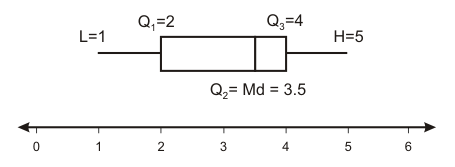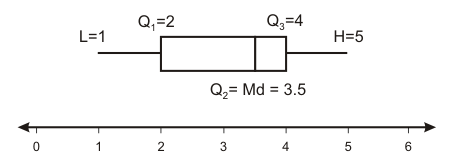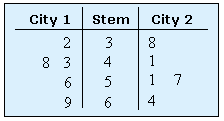Cards In This Set
| Front | Back |
|
Mean
|
 The average; most common measure of centrality; not resistant. |
|
Median
|
The midpoint; resistant; the same as the mean if the data set is symmetric.
Example: [14, 21, 23, 23] Middle numbers are 21 and 23.
21 + 23 = 44
44 ÷ 2 = 22 |
|
Quartiles
|
Shows spread of the middle half of the data.
Q1(lower quartile): cuts off lowest 25% of data; 25th percentile; median of the lower half of the data.
Q3(upper quartile): cuts off lowest 75%; 75th percentile; median of the upper half of the data.
Example: [3, 6, 7, 7, 8, 8, 9, 10, 12, 12, 15]
Q1=7 Q3=12
|
|
Interquartile Range(IQR)
|
The best measure for finding outliers; the middle 50% of a data set.
Formula: Q3-Q1
|
|
Outlier
|
A point that falls outside the IQR x 1.5 + maximum value, or the IQR x 1.5 - minimum value.
Example of finding outliers: [3, 6, 7, 7, 8, 8, 9, 10, 12, 12, 15]
(Q3-Q1): 12-7=5
(formula for finding outliers)1.5 x 5= 7.5
15(maximum)+7.5=22.5(upper outlier minimum)
3(minimum) - 7.5=-4.5(lower outlier maximum)
|
|
Five Number Summary
|
 Has a data set's minimum value, lower quartile, median, upper quartile, maximum value; itself can create a boxplot. |
|
Boxplot (Modified)
|
 A graph that uses the five number summary. |
|
Variance
|
 S2; the average of the squares of the deviations of values from the mean |
|
Standard Deviation
|
 Measures the spread by seeing how far the values are from the mean; the square root of the variance; not resistant; should only be used if the mean of a data set is chosen as its measure of centrality. |
|
Back-to-back Stemplots
|
 Good for comparing the shapes of 2 data sets or small numbers of quantitative values, but for comparing the centers or the spreads, a side-by-side boxplot would be better. They both are effective in comparing quantitative distributions. Example (with picture): City 1[32, 43, 48, 56, 69] City 2[38, 41, 51, 57, 64] |



